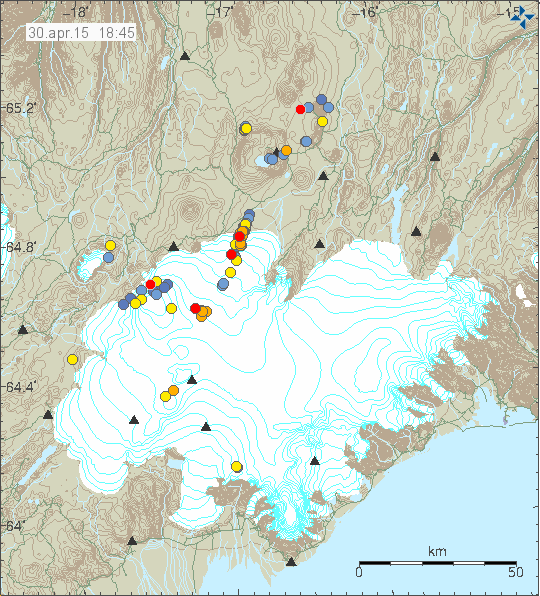Today (30-April-2015) a minor dyke intrusion took place in Bárðarbunga volcano. This dyke intrusion was small and appears to be over for now. This does show that current activity in Bárðarbunga volcano is not over even if the eruption in Holuhraun has ended.

The dyke intrusion in Bárðarbunga volcano is a small cluster of earthquakes, it can be found on this image as three orange dots and one red dot. Copyright of this image belongs to Icelandic Met Office.
Largest earthquake that appeared in the following earthquake swarm took place had the magnitude of 2,1. Depth of this earthquake swarm was around 17 km and going up to 5,3 km. Nothing suggest that at current time this dyke has reached the surface and no harmonic tremor was detected during the time this dyke intrusion took place in Bárðarbunga volcano. More dyke related activity should be expected in Bárðarbunga volcano in next few months to years. Other earthquakes in Bárðarbunga volcano are due to stress changes in the crust due to deflation the volcano came under during the eruption in Holuhraun, total subsidence of Bárðarbunga volcano during that eruption has been measured 62 meters. Current rifting activity is not over in this area even if no eruptions are taking place at the moment.

Thanks, Jón. I’d been wondering about that swarm.
THANKS THANKS, Jon.
Are the relative lateral movements of the different areas in and around the Bard still going on at the former rates?
Have any of the directions of such movements altered significantly?
It appears that the little volcano NNW of the Bard still has a small number of quakes. Though, I guess, there’s no significant movement changes in that region?
I assume the processing of the massive amount of data from the eruption events is continuing apace at the university and among officialdom there. Have there been any points, discussions, results surfacing there in Iceland about new insights from such data analysis?
Do you or any of the geologists there have any personal impressions & guesses about the rifting quakes & region SW of Iceland? e.g. do they appear to be at stable rates, increasing rates, changing depths, changing intensities etc?
I hope your new-ish home in Iceland has resulted in more comfortable and less stressful days, life relationships and doings.
Most of your questions can be answered by digging through links from this page:
http://en.vedur.is/earthquakes-and-volcanism/earthquakes
It’s also worth keeping an eye on the Icelandic media.
True.
However, Jon tends to be on top of such issues. And, I think he can offer a knowledgeable response a lot quicker than exhaustive digging when I have other priorities.
You can send an email to Jon and see if he wants to answer to that lindworm of questions. You could also try to contact IMO. Your comment above was not a comment. More like a private asking session. Think what you post and try not to upset anybody here, especially not Jon
Dyke intrusion at Mýrdalsjökull?
Small, but nice deep swarm. Keep my eyes open for more to come. 🙂
Yes, that is a dyke intrusion in Katla volcano. I am going to write a article about in next few hours.
By the way, big quake swarm W/NW of Faial Island (Azores) http://www.cvarg.azores.gov.pt/civisa/Paginas/homeCIVISA.aspx
It is difficult to know what is happening in Azores Island. This might be a volcano or just normal earthquake swarm. The area where this is taking place is under up to 2 km of ocean. If there is an eruption taking place there it would only show up on seismic sensors.
In my view (after viewing the earthquake pattern) suggests a volcano eruption or a dyke intrusion in that area of Azores Islands. Eruption might be imminent in this area, it is however difficult to know for sure.
Comment updated at 18:53 UTC.
Is that tectonic or volcanic going on in the Azores?
This dyke intrusion in Bárðarbunga volcano is bigger then I expected and when I wrote this article about it. This might lead to a new eruption soon, it is impossible to know at this moment but that is the most likely outcome in my view.
Also a swarm at Dreka and Laka. Very shallow, from 2 – 0 km. I see no harmonic tremor.
Not at all. The swarm at Dreki (Askja) is at medium/shallow depth of 2-6km.
The quakes SW of Grimsvotn on its fissure swarm are deeper, 9, 11 and 18km, but low magnitude.
Yes, magnitude is from 0 – 2.2
I’m skeptical that I’m the only one interested in such questions.
And, in this relatively ‘slow’ time, I thought it would give Jon an added opportunity to show his strengths with some interesting replies.
I certainly realize I’m not ‘one size fits all.’
I think you may possibly be mistaken (for once) on this one. After an eruption, there is always a period of time when the area stressed by the preceding intrusion de-stresses and cools down. As there was no harmonic tremor, this seems the more likely explanation and is something we’ll see a lot more of during the coming months.
At Grimsfjall, the underground noise is somewhat increasing since the beginning of May. Until today, we count 6 days of becoming louder….
Harmonic tremor was on and off for many times, but in my eyes the is different in a way. See
http://hraun.vedur.is/ja/vatnajokulsvoktun/grf1_trem.gif
http://hraun.vedur.is/ja/oroi/grf.gif
3D model of the newly formed craters at Holuhraun lava field filmed with a drone:
http://www.mbl.is/english/nature_and_travel/2015/05/07/holuhraun_seen_from_a_drone/
Nice, Mafl!
But the video is loading very slowly until it stops totally… 🙁 I had the same problem with a new SAR-vessel on the river Weser this evening. So I declare youtube guilty. I will try again tomorrow.
On that topic:
http://en.vedur.is/media/jar/Report-from-eruption-site_17-19-MAR.pdf